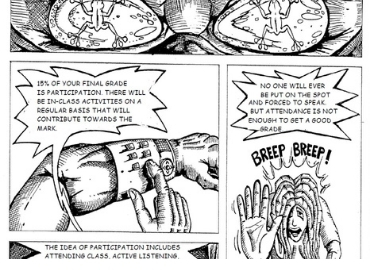David Perley is Sessional Lecturer and teaches on the STG and UTSC campuses. His course Graphic Religion: Myth and Spiritual in Graphic Novels will be taught during the summer semester. He spoke to the DSR about the course.
DSR: Can you summarize your upcoming course, Graphic Religion: Myth and the Spiritual in Graphic Novels?
DP: The course examines the intersection between religion and graphic representation from a whole bunch of different angles. It looks at how certain religious traditions might use sequential art and comic books or graphic novels as part of the tradition. We look at specific examples, such as Indian comics, Japanese manga (and its relation to religious culture in Japan), and we also look at “Jack Chick tracts,” evangelical Christian missionary pamphlets that have been published over the years.
We also explore the concept of myth and how it relates to the idea of the superhero by unpacking the history of the emergence of the superhero within its American cultural and historical context.

DSR: Are we talking about explicitly religious graphic novels? Or are we talking about reading into graphic novels to find religious subtext?
DP: It's all of that! We look at religious themes in comic books and graphic novels, and those might be explicit or more subtle, depending on the stories. From a different angle, by examining comic books or graphic novels as themselves being forms of religious expression, we see how graphic representations are connected with religious education/communication. Through the combination of text and image, graphic novels/comic books create an accessible and highly effective method of creating meaning (in our context, “religious” meaning). Building on this, within the mythical world of superheroes and comic books, we talk about how we can use the ‘superhero’ as a metaphor to read back into our understanding of religious narratives, that is, we ask how that genre mimics or mirrors some of the narrative structures we see in religious traditions.
DSR: Do they do that on purpose?
DP: In some cases, yes. There are some artists in the industry that are connected to some sense of being religious, or some sense of spirituality, who are exploring religious ideas using these characters and this form of expression. For example, the idea of the multiverse where multiple, alternative versions of characters and worlds co-exist can stand as an analogy to help interpret the radical diversity within interpretations of traditions and texts. The Hindu traditions come to mind as a strong example where there is so much radical diversity in the way that epics and stories are told, performed, expressed, reinterpreted, retold, with alternative endings and alternate realities. I'm fascinated by that connection.
DSR: So would you say religious stories lend themselves to this graphic or comic style of story telling?
DP: There is a tradition of people taking classic stories, like the Genesis story in the Hebrew Bible, and then turning that into graphic form. On a pedagogical level it's highly effective to use both images and text together, rather than just relying on the text.
DSR: When you're telling me about, for instance of the story of Genesis, I immediately think of children's stories. So is it almost like they are simplifying the story?
DP: There is a stereotypical idea that comic books, especially in the early superhero comic books in the 1940s, are intended for children or they are ‘low-brow.” But there have always been parallel alternative or indie forms of comic expression that had much more diverse intended audiences. And by the time we get to 1980s, an alternative, darker, far more mature approach to comic books is really changing the scene of even mainstream superhero comics. The one thing I do emphasize to my students is that we don't just look at the mainstream superhero stuff. I do my best to introduce students to alternative artists who have very different aesthetic and artistic aspirations. The scholarly research that has happened in the last 10-15 years explores the wide range of graphic novels/comic books that are out there. And more and more scholars are exploring the connections between graphic novels/comic books and religion. It’s an exciting time!


